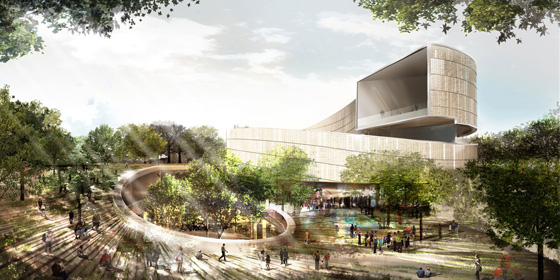
I. The city has declared that they will begin construction of the new Freelon-Group-designed library in September. However, out on the Tenleytown Listserv, discussion flared up when it became clear that the department of economic development was asking the architect to add structural columns that could support multistory residential. This practice is not uncommon, but it would be a wasteful expenditure if the Tenleytown Historical Society succeeds in landmarking the school, and adding to the structure becomes more difficult. Both properties sit on the same lot.
II. The HPRB has agreed to review a preservation application for the 1925 elementary school. Built by the city architect, Albert Harris, it’s a decent example of the stripped-down Beaux-arts Georgian style he developed for the rapid expansion of public facilities in the early 20th Century. Although it was the first of all the schools built in the area, I don’t see how the 84-year-old school merits perpetual legal protection, at least not at this point. Especially considering that the building is not in any danger of demolition or permanent alteration. Moreover, landmarking could seriously delay the much-needed renovation of the aging school needlessly.
III. The department of education is proceeding, however, with the development. They’ve hired Devrouax + Purnell to design a wing to the west of the current building. Part of the planning framework requires that DP respect the historical structures of the area. I have no doubt that they will. Their work in DC has been humane and sensitive, while also adding innovating modern elements. Freelon and DP’s buildings will be coups for the architecturally stagnated area, so it’s in the neighborhood’s interest to support their work.
IV: On the site of the former Oakcrest School at 4101 Yuma Street, a new religious center for women and girls will be opening this fall. The Yuma Study Center, a vaguely defined but Opus-Dei-affiliated religious institution will itself be renovating and expanding the old Bon Secours covenant. The current structure is dilapidated, so renovation will be welcome, once I can figure out exactly what the institution does.
Van Ness: This past weekend saw the second-ever farmers’ market on the plaza in front of UDC. The market is a twofer fer the residents of condograd across the street, putting the large plaza to use and getting farm-fresh goods onto a public street.
Hawthorne: The Post covers the ongoing slapfest in the very northern neighborhood of Hawthorne, a small collection of 1950s houses that was built in the fashion of the times: without sidewalks. DC has been improving and adding sidewalks throughout the city, improving pedestrian safety and encouraging walking, however, some residents of the area northeast of Utah Avenue won’t have any of that filthy urban nonsense. They moved there because they wanted to be in DC without being in the city.
What, they stayed in DC for the schools? Or for the lack of voting rights?
The arguments against sidewalks sort of tumble out of opponent’s mouths, with all kinds of illogic. This is like country in the city, yes, and a ranch house makes your .2 acre lot a ranch. Nobody walks around here, uh, ever wonder why? We need curbs, not sidewalks, so pedestrians can’t get out of the way of cars? Lastly, the venerable, but that’s the way it’s always been! makes its appearance, proving opponents to be examples of a certain five-letter acronym. You can hear how literally incoherent their arguments are in this video.
On the other hand, there are almost as many proponents, since many residents do see the public obligation to make the streets safe and accessible for all modes of traffic. It’s heartening to see proponents of reasonable growth out and advocating their position. There’s not much of a worry that Hawthorne will become infected with the dread contagion of urbanism, since it’s pretty far from any sort of rapid transit and unsuitable for larger growth. It’s always going to be a side neighborhood, one whose character will not be negatively altered by allowing people to walk comfortably around their neighborhood.
